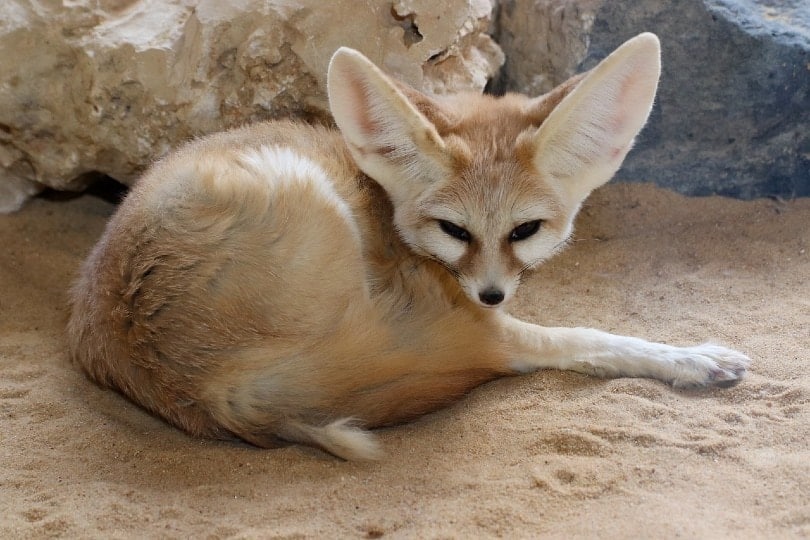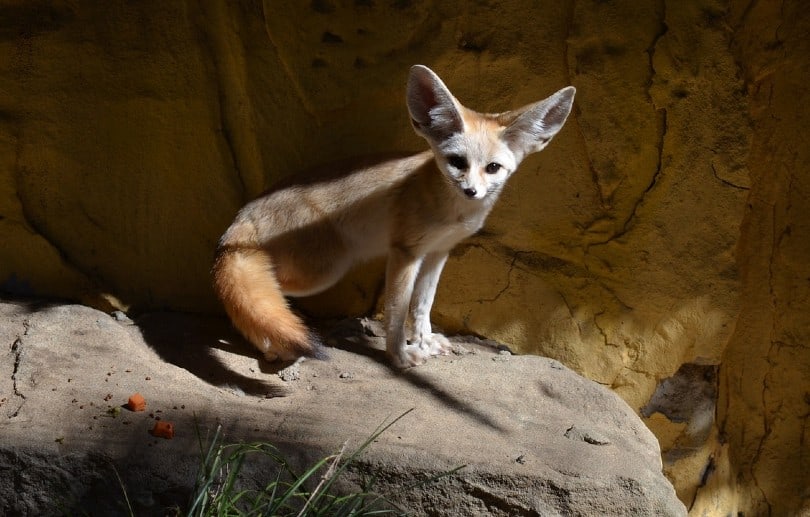Native to the Sahara Desert, the fennec fox has become an increasingly popular pet for exotic enthusiasts—where it’s legal to keep one. Whether you’re interested in what they need to survive in the wild or are trying to determine if you can care for one in captivity, it all starts with what they eat.
So, what does a fennec fox eat, and should you consider keeping one as a pet? They are omnivores and will eat a variety of plants, rodents, insects, and reptiles. Should you keep a fennec fox as a pet? That’s a question only you can answer, but Pet Keen does not endorse the keeping of wild animals for any reason other than conservation or rehabilitation.
Let’s break down everything that you need to know about these lovable creatures, so you can make an informed decision.

What Do Fennec Foxes Eat in the Wild?
In the wild, fennec foxes are opportunistic omnivores who will eat plants, rodents, insects, reptiles, and just about anything else.
Fennec foxes are particularly fond of locusts, grasshoppers, lizards, birds, eggs, fruits, and leaves. They need to eat a variety of these foods because they don’t drink much water. Instead, their body has a unique metabolism that allows them to collect water from the food that they eat. This adaptation has helped desert foxes survive in arid conditions
Keep in mind that fennec foxes are the smallest fox type in the world, and this affects the size of their prey. They only go after smaller animals, which is why they are so fond of insects and small reptiles.
They are especially adept at digging, as they dig to unearth much of their prey.

Fennec Foxes as Pets
While we can’t recommend keeping a fennec fox as a pet, there’s little doubt that these animals have a cult-like following in the pet world. All it takes is one look at their adorable faces to see why.
But while they’re extremely adorable, they present a litany of concerns that you would need to address if you wanted to keep one as a pet. First, they’re not domesticated like dogs, cats, and other pets. This means that they’re always going to have an independent streak and won’t be cuddly.
In fact, it might take them a while to even see you as their caretaker instead of a threat. They’re incredibly skittish, but they will bite if they feel threatened and trapped.
Another potential concern is their activity level. Fennec foxes are extremely active but they’re also nocturnal. That means you need to find a way to keep them exercised and happy, and you have to do it at night.
They act more like a cat than a dog in many respects, as they’ll jump over furniture, scratch, and dig, and you can train them to use a litter box.
But these all might seem like minor concerns to a dedicated owner. The biggest problem is that it’s illegal to own a fennec fox in many states and jurisdictions. Before heading out and making a purchase, check all the local and state laws so you don’t run afoul of the law on accident.
Fennec Foxes’ Diet in Captivity
While many owners opt to feed their fennec fox a mix of dog food, cat food, vegetables, and fruit, this isn’t their ideal diet. They are omnivores in the wild and they need food that matches this.
Zoos feed fennec foxes a commercial wild canid diet, and this consists of about 90% animals and 10% plants. This is a much harder diet to keep up with if you own one as a pet, but it’s what they need to stay healthy.
Since it can be challenging to track down where to buy this food, you might need to come up with the food yourself.
This diet constitutes crickets, mealworms, waxworms, fruits, and vegetables. These foods have the nutrients that they need and won’t get with dog food.

Where Do Fennec Foxes Live?
Fennec foxes are native to North Africa, especially the sandy Sahara. The desert habitat is why many people refer to the fennec fox as the desert fox. Moreover, this harsh terrain explains why they have various personality quirks, such as getting most of the water they need from their food and digging for many of their meal choices. Their smaller size also makes it so their prey underground can’t feel them moving around.
These small foxes have large ears for two purposes. First, they help the fox hear animals moving around under the sand. They need to have extremely adept hearing to listen to these small movements.
Second, their large ears help keep them cool. They act like fins to help dispel heat, which is a huge perk in the Saharan desert.
Interesting Fennec Foxes Facts
The fennec fox is more than just a cute wild animal. They’re full of quirks and personality, and this only adds to their overall adorableness.
- Fennec foxes purr like a cat.
- They can dig holes up to 20 feet deep!
- They have a scent gland in their tail that produces a musky scent when they’re startled.
- Fennec foxes are outstanding climbers.
- They have hairy feet to insulate them against the hot sand.
- Fennec foxes live in underground dens.
- Fennec foxes like lying out in the sun.
- Related Read: Do Foxes Purr? The Interesting Answer!

Final Thoughts
There’s a reason that many states and local jurisdictions have outlawed owning a fennec fox. These animals are extremely cute and adorable, but they’re also notoriously challenging to care for, especially due to all the complexities in their diet.
So, while you might want to bring one of these adorable animals home, you’re likely better off just viewing them on your next trip to the zoo!
Featured Image Credit: Cifer88, Pixabay
